Beyond Numbers: How HR Data Analytics Transforms Workforce Strategy

HR data analytics has come a long way. It's no longer just about basic reporting. It's become a powerful force for shaping workforce strategy, giving HR professionals deeper insights into their teams, revealing important trends, and empowering them to make data-driven decisions that benefit the whole organization. This evolution isn't about simply gathering data; it's about using it wisely to reach crucial business goals. This means HR can now directly contribute to an organization's bottom line, transitioning from a cost center to a true strategic partner.
The Shift Towards Predictive Analytics
One of the most exciting advancements in HR data analytics is the rise of predictive analytics. This method uses historical data to anticipate future patterns, empowering businesses to be proactive instead of reactive.
Imagine being able to foresee potential employee turnover. Predictive analytics can do just that. By analyzing factors like compensation, performance reviews, and internal movement, it can help identify those at risk of leaving. Armed with this knowledge, HR can develop targeted interventions to boost retention and decrease the high cost of replacing valuable employees. This represents a significant change in how we approach workforce planning.
The growing emphasis on predictive workforce analytics further emphasizes its vital role in shaping the future of work. A recent report highlighted this trend, revealing that 49% of HR leaders have identified the future of work as a top priority, with 46% increasing their investment in related strategies. Want to delve deeper into this topic? Check out this insightful article: What's Next for HR Analytics? 5 Key Trends
From Reactive to Proactive Workforce Management
In the past, HR often operated in a reactive mode, addressing situations after they occurred. However, with the power of HR data analytics, organizations can anticipate future needs and take proactive steps to address them. This shift has major implications for critical areas like talent acquisition, performance management, and employee engagement.
For example, HR can forecast hiring needs based on projected growth and attrition rates. This ensures the organization has the right talent, with the right skills, at the right time. This proactive approach allows for more strategic talent acquisition, leading to better hiring choices and a stronger workforce overall.
Aligning HR with Business Objectives
HR data analytics fosters a stronger connection between HR initiatives and overall business objectives. By connecting HR metrics to business outcomes, HR can showcase its strategic value and directly contribute to the organization's success.
Imagine demonstrating the link between happy employees and satisfied customers. By analyzing the correlation between employee engagement and customer satisfaction, HR can illustrate the direct impact of their work on business performance. This data-driven approach not only boosts the credibility of HR but also guarantees resources are used wisely and effectively.
Key Applications of HR Data Analytics
- Talent Acquisition: Optimize your recruiting strategies, improve time-to-fill for open positions, and minimize cost-per-hire.
- Performance Management: Pinpoint high-potential employees, enhance performance reviews, and create customized development programs.
- Employee Engagement: Understand what drives engagement, address potential problems proactively, and boost employee retention.
- Workforce Planning: Predict future workforce needs, optimize staffing levels, and effectively manage your talent pipelines.
HR data analytics is more than just number crunching. It’s about empowering organizations to make informed choices about their most important asset: their people. By harnessing the power of data, HR can revolutionize workforce strategy, drive better business results, and cultivate a more engaged and productive workforce.
Metrics That Matter: Building Your HR Analytics Dashboard
In the realm of HR, data is power. But not all data points are created equal. Choosing the right Key Performance Indicators (KPIs) is the cornerstone of a successful HR analytics strategy. It's about selecting the metrics that truly align with your organization's strategic goals, guiding you toward meaningful business outcomes.
Identifying Key HR Metrics
Think of your HR analytics dashboard as the control panel for your workforce. Just like the instruments in a car, your dashboard should display the metrics most vital to your organization's journey. Which indicators will illuminate your path to success?
-
For recruitment, understanding how efficiently you're bringing talent on board is key. Metrics like time-to-fill and cost-per-hire provide valuable insights into your hiring process, helping you identify bottlenecks and streamline your approach.
-
To understand employee engagement, tap into the pulse of your workforce. Track metrics like employee Net Promoter Score (eNPS) and pulse survey results to get real-time feedback on employee sentiment. These valuable insights can help you create a more positive and productive work environment.
-
For retention efforts, focus on understanding why employees choose to leave. Analyzing turnover rates and conducting exit interviews can uncover hidden patterns and provide the knowledge needed to build a more engaged and loyal workforce.
By carefully selecting the metrics that address your specific needs, you create a dashboard that tells a compelling story about your workforce, empowering you to make data-driven decisions.
Building an Effective HR Analytics Dashboard
Building an effective HR analytics dashboard is more than just presenting numbers; it's about transforming raw data into actionable strategies. Consider these key aspects:
-
Audience: Tailor the dashboard to the specific needs of its users, whether they are executives, managers, or HR professionals. Ensure the data presented is relevant and easily understood by each group.
-
Visualizations: Use clear charts and graphs to present data in a visually compelling way. Transforming complex data into easily digestible visuals helps stakeholders quickly grasp key insights.
-
Actionable Insights: Focus on providing information that empowers decision-making. Your dashboard should not only show what's happening but also suggest how to improve, driving positive change within the organization.
A well-designed dashboard isn't just a reporting tool; it's a strategic asset, providing a clear roadmap for achieving your HR goals.
To understand the power of data-driven HR, let's look at some key metrics categorized by business objective:
To understand how these metrics can drive your HR strategy, let's examine them in more detail:
Critical HR Analytics Metrics by Business Objective
| Business Objective | Primary Metrics | Secondary Metrics | Measurement Frequency | Benchmark Standards |
|---|---|---|---|---|
| Improve Employee Retention | Turnover Rate, Employee Satisfaction | Exit Interview Feedback, Employee Net Promoter Score (eNPS) | Quarterly/Annually | Industry Averages, Internal Trends |
| Optimize Recruitment Effectiveness | Time-to-Fill, Cost-per-Hire | Candidate Experience Ratings, Source of Hire | Monthly/Quarterly | Industry Benchmarks, Internal Targets |
| Enhance Employee Engagement | eNPS, Pulse Survey Results | Employee Participation in Development Programs, Internal Mobility Rate | Ongoing/Quarterly | Best-in-Class Organizations, Internal Trends |
| Improve Workforce Planning | Headcount, Employee Demographics | Skills Gap Analysis, Succession Planning Metrics | Annually/Bi-Annually | Industry Trends, Organizational Growth Projections |
| Increase Employee Productivity | Revenue per Employee, Performance Ratings | Employee Absenteeism Rate, Training Completion Rate | Quarterly/Annually | Industry Averages, Internal Goals |
This table provides a clear overview of how various HR metrics contribute to specific business objectives. By tracking and analyzing these metrics, HR professionals can gain valuable insights into workforce trends and identify areas for improvement.
Traditional vs. Emerging HR Metrics
While traditional metrics like turnover rate and employee satisfaction continue to hold value, emerging indicators offer even more granular insights. Analyzing data from internal communication platforms can reveal hidden patterns of collaboration and identify key influencers within the organization. Incorporating external data, such as market salary benchmarks from sites like Salary.com, ensures your compensation strategies remain competitive.
By blending traditional and emerging metrics, you gain a comprehensive understanding of your workforce, enabling you to anticipate challenges and capitalize on opportunities. HR analytics isn't just about understanding the past; it's about shaping a brighter future for your organization.
The Tech Behind the Transformation: HR Analytics Platforms
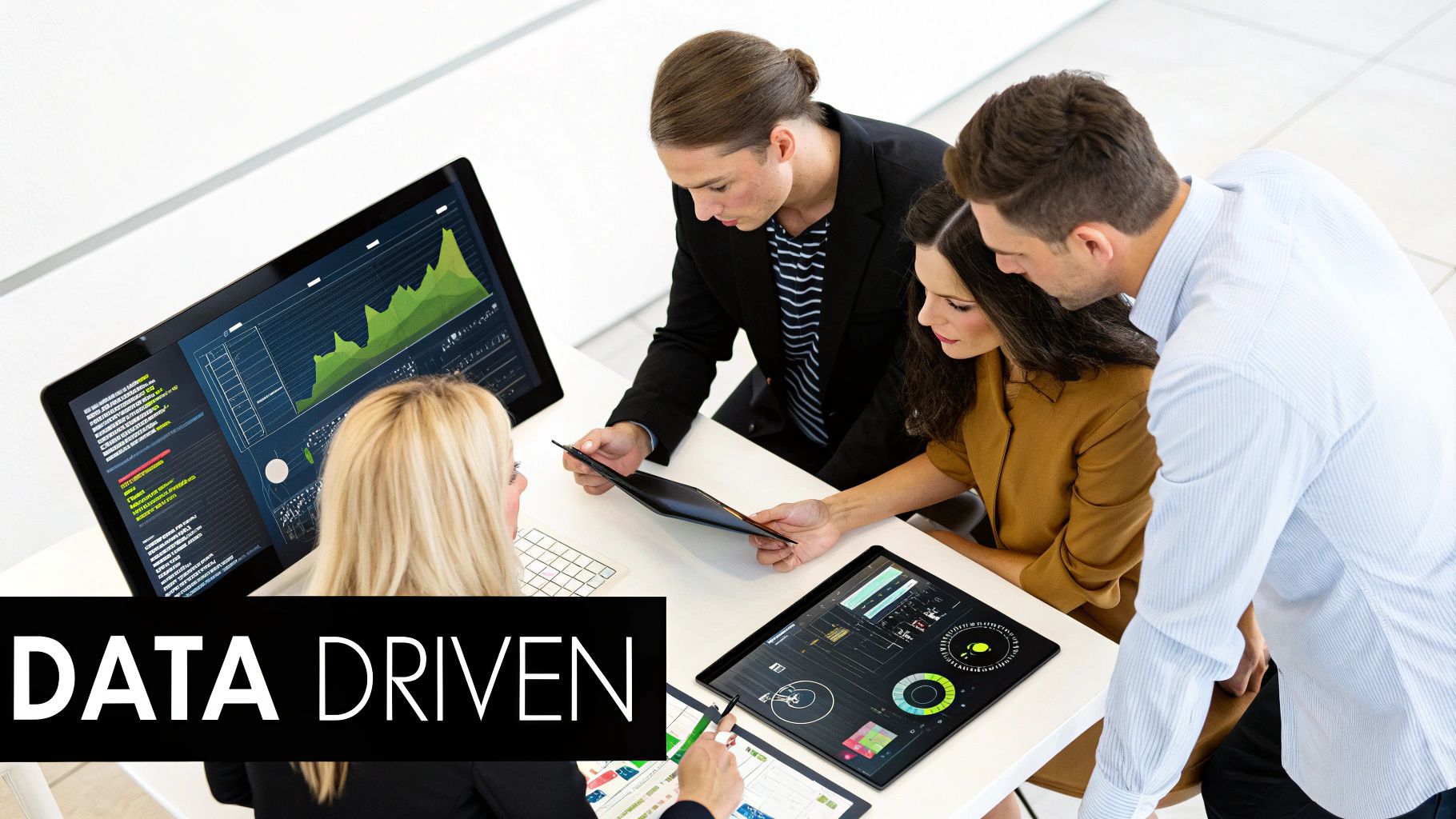
Today's HR departments are increasingly empowered by technology to unlock the true potential of HR data analytics. This exciting shift has cultivated a diverse ecosystem of HR analytics platforms, offering tailored solutions for organizations of every size and stage of development. These platforms span the spectrum from specialized tools honed for specific areas like recruitment or performance management, to comprehensive suites encompassing the entire employee lifecycle. Choosing the right technology is paramount to building a thriving HR analytics function.
Navigating the HR Tech Landscape
Understanding the diverse landscape of HR analytics platforms is the first step toward selecting the perfect fit for your organization. This involves carefully assessing your current needs, future aspirations, and existing technical capabilities.
-
Specialized Platforms: These platforms zero in on specific HR functions. For example, some tools specialize in recruitment analytics, providing valuable insights into time-to-fill, cost-per-hire, and candidate quality. Others may focus on performance management, offering data-driven evaluations and personalized development plans. These specialized platforms offer an excellent entry point for organizations embarking on their HR data analytics journey.
-
Integrated Suites: Integrated suites offer a panoramic view of your workforce by seamlessly integrating data from various HR functions into a unified platform. This comprehensive approach facilitates deeper analysis, unveiling powerful connections between seemingly disparate areas like recruitment, engagement, and retention. These platforms are perfectly suited for established organizations seeking deeper insights and more strategic decision-making.
-
HRIS Modules: Many modern Human Resource Information Systems (HRIS) now incorporate built-in analytics modules. These modules offer essential reporting and analysis capabilities, often sufficient for organizations with less complex needs. While convenient, they may not offer the advanced features and customization options found in dedicated analytics platforms.
To help you navigate this landscape, we've compiled a comparison of leading HR analytics platforms:
HR Analytics Platform Comparison
A detailed comparison of leading HR analytics platforms, highlighting their features, strengths, limitations, and ideal use cases.
| Platform | Core Capabilities | Integration Options | Predictive Features | Price Range | Best For |
|---|---|---|---|---|---|
| Visier People | Workforce planning, talent acquisition, performance management | Wide range of HRIS and other business systems | Turnover prediction, employee flight risk | High | Enterprise organizations |
| OrgVue | Workforce modeling, scenario planning, organizational design | Integrates with HRIS and talent management systems | Skills gap analysis, succession planning | Mid-range | Medium to large businesses |
| Tableau | Data visualization, reporting, dashboard creation | Connects to various data sources including HRIS | Customizable predictive models | Mid-range | Data-driven HR teams |
| People Analytics (SAP SuccessFactors) | Employee experience management, performance and goals, core HR | Part of the SAP SuccessFactors suite | Performance predictions, employee attrition analysis | High | Large enterprises using SAP SuccessFactors |
This table provides a starting point for your research. Remember to thoroughly evaluate each platform based on your specific needs and requirements.
Choosing the Right Platform for Your Needs
Selecting the right HR analytics platform demands careful consideration of several key factors. This includes evaluating features, integration capabilities, and cost-effectiveness.
-
Integration Options: Seamless integration with existing HR systems, such as your HRIS, payroll system, and Applicant Tracking System (ATS), is essential for data accuracy and efficiency. Prioritize platforms that offer robust integration capabilities to eliminate manual data entry and ensure data consistency.
-
Predictive Capabilities: The ability to anticipate future trends is a significant advantage of HR data analytics. When evaluating platforms, pay close attention to their predictive analytics features, such as algorithms for predicting employee turnover or identifying high-potential employees. This proactive approach empowers organizations to make informed decisions and stay ahead of the curve.
-
Data Security and Privacy: Protecting sensitive employee data is non-negotiable. Ensure the chosen platform adheres to all relevant data privacy regulations and offers robust security measures. This includes data encryption, access controls, and secure storage.
A compelling statistic highlighting the impact of HR data analytics is its power to elevate HR through technology and analytics. A study by PeopleHum reveals that 89% of HR leaders recognize the importance of predictive analytics for the future of HR management. Furthermore, HR technology is now a top priority for 46% of HR leaders. This encompasses the use of AI in talent acquisition, employee training, and people analytics. The effective integration of HR technology and analytics not only streamlines recruitment but also strengthens strategic HR decisions, such as optimizing training programs and boosting employee engagement. This underscores the growing reliance on data-driven insights to shape HR strategies and improve organizational outcomes. Discover more insightful statistics here: HR Trends
The Future of HR Analytics Platforms
Emerging technologies like machine learning and artificial intelligence (AI) are revolutionizing the potential of HR analytics platforms. AI-powered platforms can automate tasks like data cleaning and analysis, freeing up HR professionals to focus on strategic initiatives. Machine learning algorithms can uncover hidden patterns and insights that humans might overlook, leading to more accurate predictions and more effective decision-making. These advancements will continue to reshape HR data analytics, creating exciting new possibilities for understanding and managing the workforce. As technology advances, HR analytics platforms will play an increasingly vital role in driving organizational success.
From Theory to Practice: Implementing HR Data Analytics
Implementing HR data analytics isn't about flipping a switch. It's a journey. A journey that requires careful planning, dedicated resources, and a commitment to continuous improvement. This section offers a practical roadmap for implementing HR data analytics, guiding you through each critical step, from securing executive buy-in to showcasing those early wins that will help build momentum.
Assessing Your Organization's Analytics Maturity
Before diving into implementation, take a moment to assess your organization's current analytics capabilities. This assessment helps tailor a phased approach that aligns with your specific needs and resources. It's like planning a road trip: you need to know where you're starting from before you can map the best route.
-
Basic Reporting: At this stage, HR primarily uses data for fundamental reporting, such as headcount and turnover rates. The focus is on descriptive analytics, summarizing what has already happened.
-
Advanced Reporting: Organizations at this level start exploring deeper insights. They use data to identify trends and patterns, potentially analyzing data from multiple sources and using visualization tools like Tableau to communicate findings.
-
Predictive Analytics: Here, organizations use data to predict future outcomes, like employee turnover or future hiring needs. This involves using statistical modeling and machine learning techniques.
-
Prescriptive Analytics: At the most advanced level, organizations use data to prescribe actions that will lead to desired results. This might involve using algorithms to optimize workforce planning or personalize employee development programs.
Knowing your starting point is crucial for creating a realistic and effective implementation plan.
Building a Phased Implementation Plan
Once you've assessed your current analytics maturity, you can create a phased implementation plan. This plan should outline clear goals, timelines, and resource requirements for every phase. Like building a house, a strong foundation is essential before adding the walls and roof.
-
Phase 1: Focus on Foundational Metrics: Begin by focusing on key HR metrics that align with your organization's overall strategic goals. For example, if retention is a major priority, focus on metrics like turnover rate and employee satisfaction.
-
Phase 2: Enhance Data Collection and Quality: As you progress, prioritize improving the quality and consistency of your data. This could involve implementing a centralized HRIS (Human Resource Information System) or developing data governance policies. Accurate data is the lifeblood of effective analytics.
-
Phase 3: Develop Analytics Capabilities: Invest in growing the necessary analytics skills within your HR team. This might involve training current team members or recruiting specialized analysts. Giving your team the right tools and training is critical to achieving long-term success.
-
Phase 4: Embrace Advanced Analytics Techniques: As your capabilities mature, explore advanced analytics techniques like predictive modeling and machine learning. These tools can reveal even more valuable insights to support proactive decision-making.
This phased approach helps build a sustainable analytics function that delivers true value to the business.
Addressing Implementation Challenges
Implementing HR data analytics will have its challenges. Data quality problems, skill gaps, and resistance to new processes can all hinder your progress. However, with proactive planning and open communication, these hurdles can be overcome.
-
Data Quality: Inaccurate or incomplete data can compromise your analysis. Establish clear data governance policies and invest in data cleaning and validation tools to maintain data integrity. Clean data is the foundation of reliable insights.
-
Skill Gaps: HR teams might lack the analytical skills to effectively interpret data. Provide training, or partner with other analytics teams within the organization to bridge this knowledge gap.
-
Resistance to Change: Some individuals may be hesitant to adopt a more data-driven approach. Communicate the clear benefits of HR data analytics and celebrate early successes to foster understanding and support. Tangible results are a powerful way to gain buy-in.
By addressing these challenges head-on, you'll ensure a smoother, more successful implementation process. HR data analytics offers the potential to revolutionize your workforce strategy and drive business success. It allows you to move beyond simply reporting on the past and empowers you to actively shape the future of your organization.
Predicting Tomorrow: The Power of Predictive HR Analytics
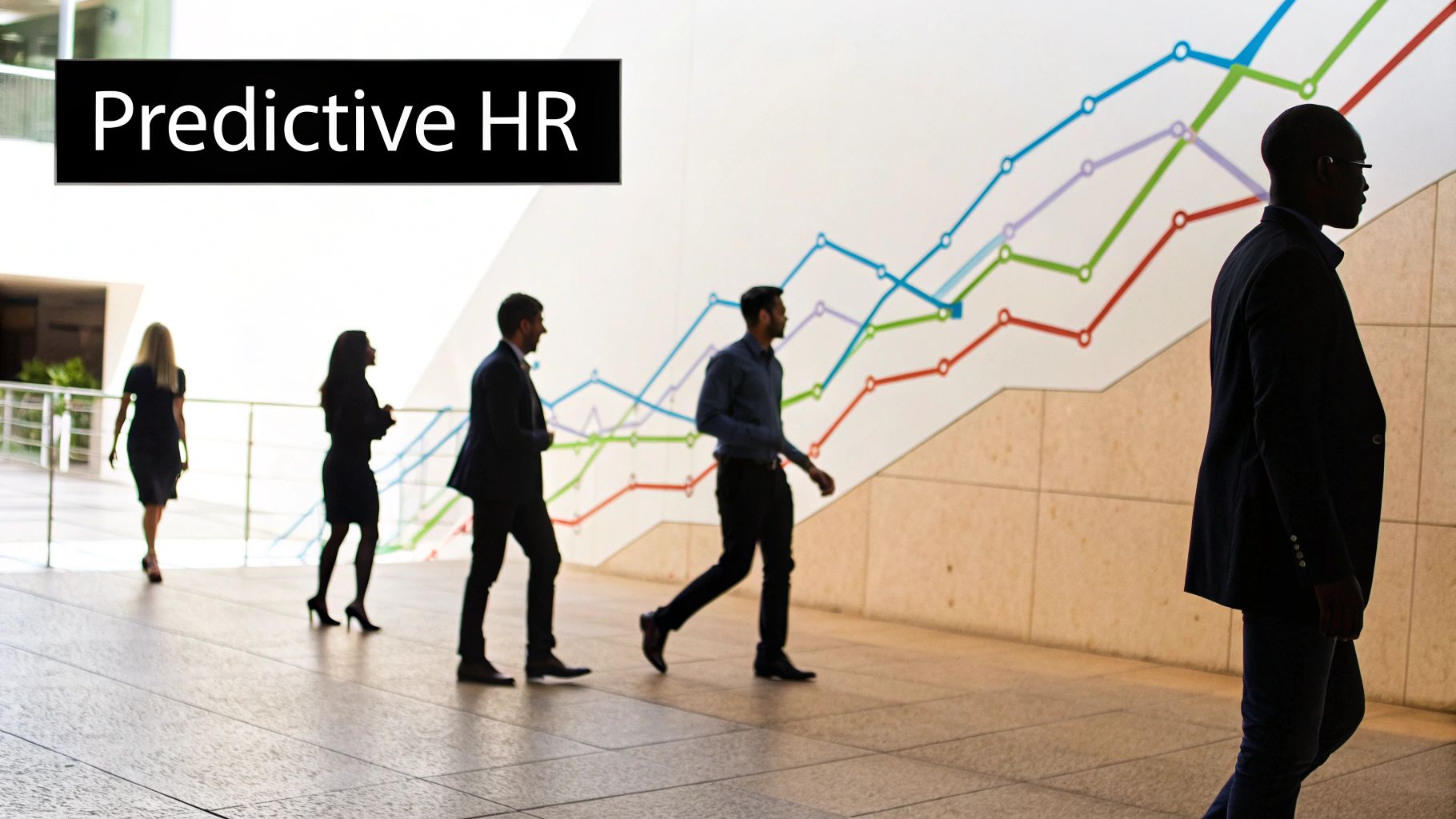
Predictive HR analytics is transforming workforce management. It empowers organizations to move beyond simply reacting to the past and instead proactively shape the future of their workforce. This proactive approach uses historical data to anticipate future needs and trends, offering valuable insights for strategic decision-making.
Forecasting Future Needs With HR Data Analytics
One of the most powerful applications of predictive HR analytics is forecasting future workforce needs. By analyzing historical data on employee turnover, organizational growth, and broader economic conditions, organizations can anticipate upcoming hiring needs.
This foresight allows for proactive recruitment planning, ensuring the right talent is available at the right time. Predictive models can also highlight potential skill gaps, enabling organizations to invest in targeted training and development programs.
Identifying Retention Risks
Predictive HR analytics plays a crucial role in minimizing employee turnover. By analyzing data like employee performance, compensation, and engagement, predictive models can identify individuals at risk of leaving.
This allows HR to intervene proactively. They can offer support, development opportunities, or incentives to retain valuable employees. For example, if data suggests employees in a specific department are leaving due to limited career growth, HR can create tailored development programs.
Predicting Performance Trajectories
Understanding and predicting employee performance is made easier with predictive HR analytics. By analyzing historical performance data, along with factors like training completed and project involvement, organizations can identify high-potential employees early on.
This identification enables targeted development programs and succession planning, ensuring a robust leadership pipeline. Predictive models also pinpoint factors contributing to high and low performance, informing the creation of more effective performance management strategies.
Optimizing Talent Acquisition Strategies
Predictive analytics can revolutionize talent acquisition. It enables data-driven decisions throughout the hiring process. Analyzing data like application sources, interview results, and assessment scores allows organizations to optimize their sourcing, improve candidate experience, and make better hiring decisions.
For instance, if data shows a particular recruiting source consistently yields high-quality candidates, the organization can invest more in that channel. Predictive models also help identify the best interview questions and assessment criteria for a more efficient and objective process.
Ethical Considerations and Potential Pitfalls
While predictive HR analytics offers immense potential, it's essential to address ethical implications and potential challenges. Data privacy and security are paramount. Organizations must be transparent about how they collect and utilize employee data, safeguarding sensitive information.
It's also crucial to avoid biases in the data and algorithms. Regularly auditing and validating predictive models helps mitigate risks, ensuring that HR analytics initiatives are both effective and ethical. These practices, coupled with strong data governance frameworks, build trust and maintain ethical standards.
This ethical approach protects employees and ensures the long-term success of HR analytics initiatives. By focusing on responsible and transparent data practices, organizations can realize the full potential of predictive HR analytics while protecting employee rights and fostering a culture of trust. The future of HR data analytics depends on this balance between innovative application and ethical implementation.
Building Your Dream Team: HR Analytics Talent and Capabilities
Behind every successful HR analytics program is a skilled team. Assembling individuals with the right blend of technical expertise, business acumen, and communication skills is essential. This section explores the evolving talent profile needed for data-driven HR and reveals effective strategies for building a high-performing analytics team.
Identifying Key Roles in HR Analytics
HR analytics teams often require a mix of specialized roles, each contributing unique skills. These roles range from technical experts to strategic interpreters who bridge the gap between data and business decisions.
-
HR Data Analyst: This role requires proficiency in data manipulation and statistical analysis. These analysts clean, transform, and analyze HR data, extracting meaningful insights to inform decision-making.
-
HR Data Scientist: Data scientists possess advanced statistical modeling and machine learning expertise. They develop predictive models, uncover complex patterns, and provide advanced analytical support for strategic HR initiatives.
-
HR Business Partner: This role acts as the bridge between HR analytics and business stakeholders. HR Business Partners possess strong communication and consulting skills, translating data insights into actionable recommendations for business leaders. They ensure HR analytics initiatives directly address business challenges and contribute to organizational goals.
-
HRIS Specialist: As custodians of HR data, HRIS specialists are crucial. They manage and maintain the HRIS (Human Resource Information System), ensuring data quality, integrity, and accessibility for analysis.
Building a robust HR analytics function often involves a combination of these roles, with specific responsibilities adjusted based on organizational needs and size.
Upskilling Your Existing HR Team
Developing internal talent is a cost-effective strategy for building HR analytics capabilities. Many HR professionals already possess valuable domain expertise. Equipping them with data literacy skills can significantly enhance their contributions.
-
Data Analysis Training: Provide training programs in data analysis tools and techniques. Courses in Excel, Tableau, or statistical software can empower HR staff to interpret and use data effectively.
-
Data Storytelling Workshops: Enhance communication skills through data storytelling workshops. These programs teach HR professionals how to present data insights in a compelling and accessible way, influencing stakeholders and driving action.
-
Mentorship Programs: Pair experienced data analysts with HR professionals to foster knowledge transfer and accelerate skill development. This personalized guidance can significantly boost their data literacy.
Investing in the development of your current HR team can create a data-driven culture within the department. This empowers individuals and strengthens the overall analytical capacity of the organization.
Recruiting Specialized Talent
While upskilling is important, recruiting specialists may be necessary to address specific skill gaps or manage complex projects. Attracting top talent requires showcasing the exciting challenges and growth opportunities within HR analytics.
-
Highlight Career Growth Potential: Emphasize the growing importance of HR analytics and the career advancement it offers. This attracts ambitious professionals seeking to make a real impact.
-
Showcase Data-Driven Culture: Promote your organization's commitment to data-driven decision-making and the strategic role of HR analytics in achieving business goals. This appeals to candidates passionate about using data to solve real-world business problems.
-
Offer Competitive Compensation: Conduct market research to ensure competitive compensation and benefits packages for specialized HR analytics roles. This attracts and retains top talent and demonstrates the value placed on these skills.
Strategic recruitment efforts can build a team capable of handling the complex demands of modern HR analytics.
Building Cross-Functional Partnerships
HR analytics doesn't operate in isolation. Collaborating with other analytics teams within the organization, such as finance or marketing, can unlock valuable insights. Sharing data and expertise across departments enhances the scope and impact of HR initiatives. For example, linking HR data with sales data can reveal the impact of employee engagement on revenue generation.
By building strong cross-functional relationships, HR analytics teams can gain access to broader datasets, learn best practices, and ensure HR initiatives align with overall business objectives. This collaborative approach maximizes the value of HR data and strengthens its strategic contribution.
The Future of HR Data Analytics: What's Next on the Horizon
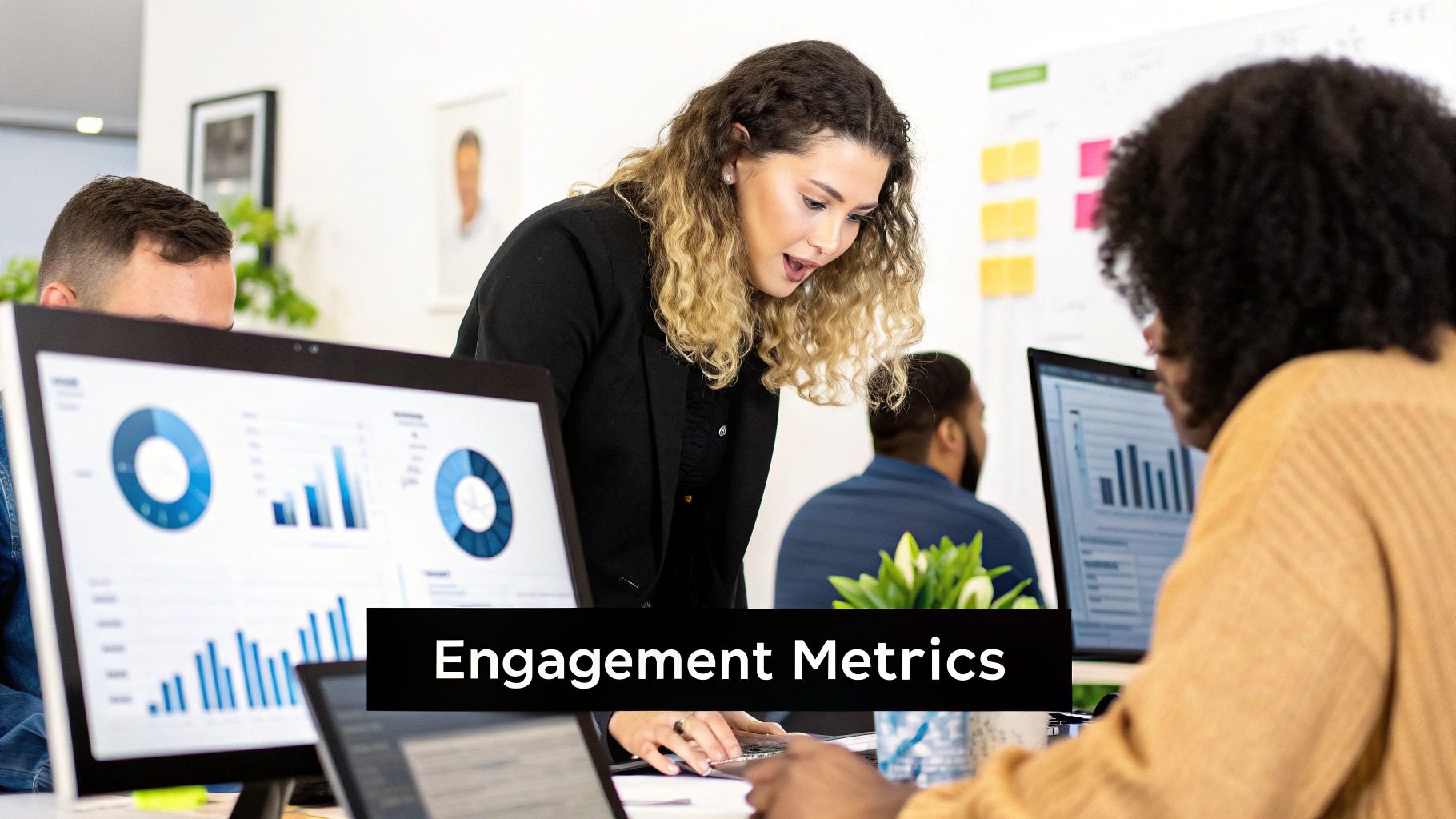
The field of HR data analytics is constantly evolving. Understanding emerging trends is essential for organizations striving to stay ahead of the curve. This exploration delves into the exciting future of this field, highlighting how advancements in technology, methodology, and application are shaping the next generation of workforce intelligence.
The Rise of Artificial Intelligence and Machine Learning
Artificial Intelligence (AI) and Machine Learning are transforming HR data analytics. These technologies offer incredible potential for understanding employee experience, predicting behavior, and personalizing support.
Imagine AI-powered chatbots providing instant, tailored assistance to employees, answering their questions and resolving issues in real-time. Machine learning algorithms can sift through mountains of data to pinpoint the factors contributing to employee turnover, empowering HR to create highly effective retention strategies. This marks a significant shift in how organizations use data to manage their workforce.
Deeper Insights Through Natural Language Processing and Sentiment Analysis
Natural Language Processing (NLP) and sentiment analysis are unlocking deeper insights into company culture and employee engagement. NLP algorithms can analyze text from employee surveys, emails, and chat logs to understand employee sentiment and identify emerging trends.
This valuable information can enhance communication, address employee concerns, and cultivate a more positive work environment. Sentiment analysis, in particular, helps organizations gauge employee morale and identify potential issues before they escalate, offering a powerful window into the human dynamics of an organization.
The Growing Importance of Ethical Considerations and Data Privacy
As HR data analytics becomes more sophisticated, the ethical implications and data privacy are paramount. Organizations must carefully consider the balance between the benefits of data analysis and the responsibility to protect employee privacy.
This requires implementing robust data governance frameworks, being transparent about data collection practices, and adhering to regulations. It's crucial for organizations to use AI and machine learning responsibly to prevent bias and discrimination. Responsible data use is not just a legal requirement, but also fundamental for building employee trust and fostering a positive organizational culture. Prioritizing data privacy and security demonstrates a commitment to safeguarding sensitive information.
The Expanding Role of HR Data Analytics in Strategic Decision-Making
HR data analytics is no longer limited to the HR department. Its insights are increasingly influencing strategic decisions across the entire organization. HR professionals now need strong business acumen and communication skills to translate data insights into actionable recommendations for leadership.
By collaborating with other departments and aligning HR analytics initiatives with broader business goals, HR can demonstrate its strategic value and contribute significantly to organizational success. HR data analytics can inform decisions related to workforce planning, talent acquisition, and organizational development. This broader role requires a shift in mindset, empowering HR professionals to become not just data interpreters, but strategic business advisors. The future of HR data analytics lies in its ability to inform and shape decisions at the highest levels of an organization.
Want to elevate your HR data analytics skills and become a leader in this evolving field? Explore the comprehensive courses and certifications available at the Global Human Resource Institute. Visit https://www.globalhrinstitute.website to discover how their programs can prepare you for the future of HR.
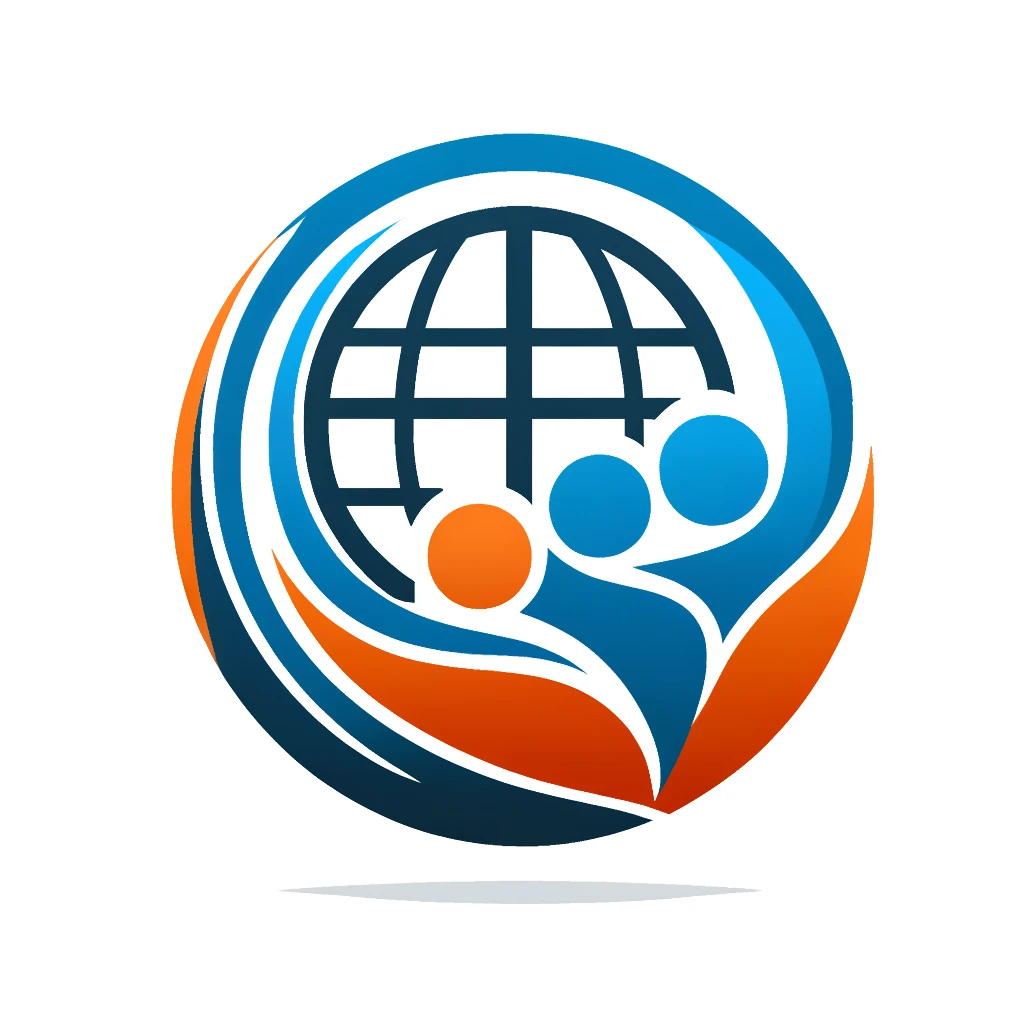

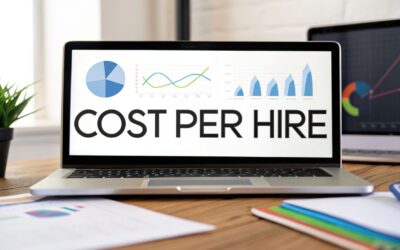

0 Comments